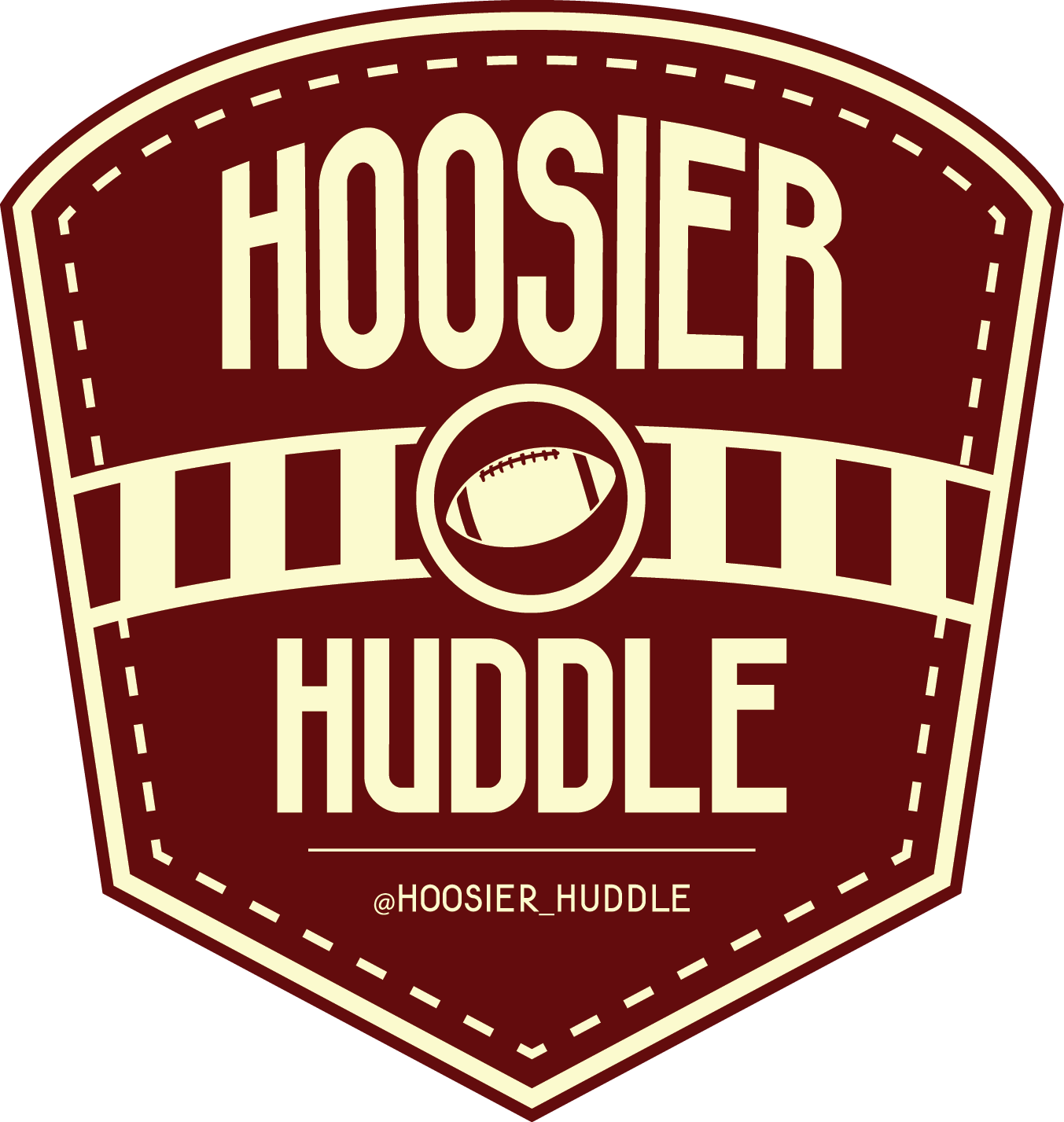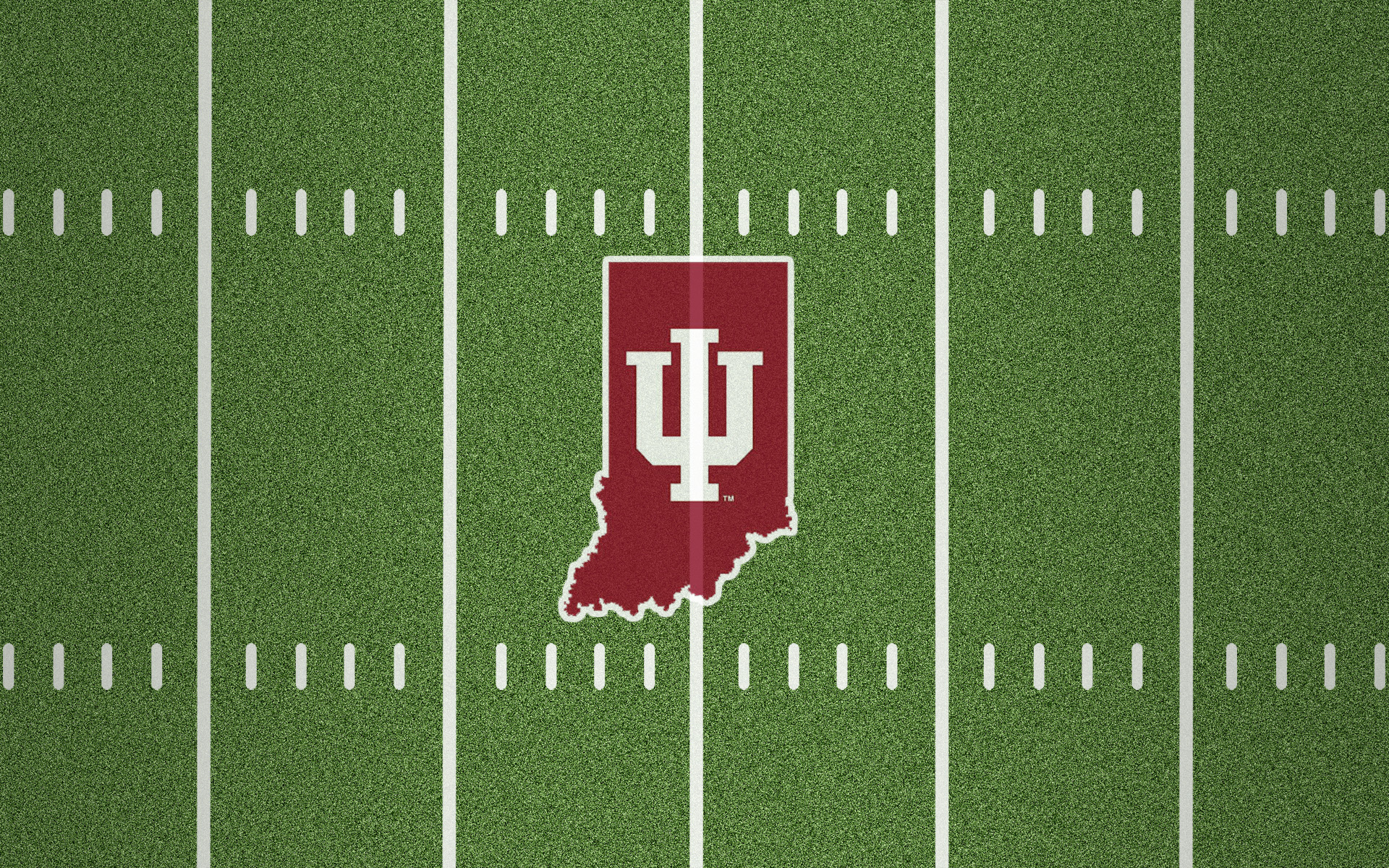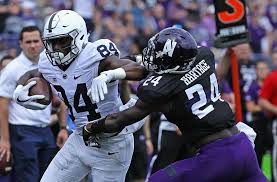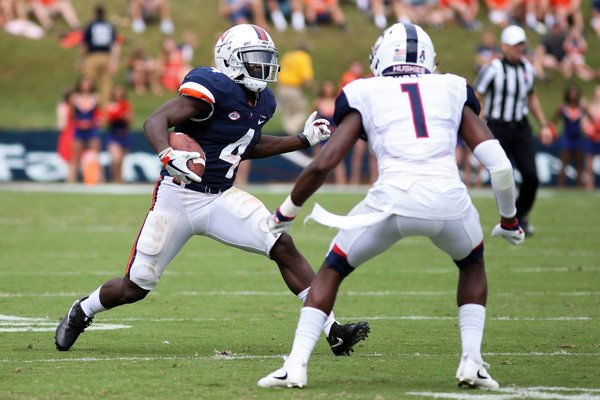Ranking the Wide Receiving Corps IU's Defense Will Face in 2018
/Image: Sammy Jacobs Hoosier Huddle
Written By Nathan Comp
We continue to examine Indiana’s 2018 opponents as we draw closer to the beginning of the season on September 1st at Florida International. Today we will preview Indiana opponent’s wide receivers. Receiver can be an interesting position to analyze because quarterback play has so much to do with receiver statistics. Historically, wide receiver has been a position the Big Ten has struggled to produce first-round NFL talent; the Big Ten has only had two receivers taken in the first round of the NFL Draft since 2007, including this past year when Maryland’s DJ Moore was selected 24th overall to the Carolina Panthers. Nonetheless, this is how we see the talent stacking up for the 2018 season.
1. Ohio State: Parris Campbell, KJ Hill, twelve other scholarship receivers
It has become commonplace for the Buckeyes to find themselves at the top of college football rankings, and this list will prove no different. Despite having to break in a new quarterback with the departure of JT Barrett, Ohio State boasts an extremely deep receivers room that should prove quite dangerous. Four receivers were eligible to enter the 2018 NFL Draft, however, all four opted to stay. This left a deep and talented group of 14 total scholarship receivers for Urban Meyer to work with.
The group will be headlined by redshirt senior Parris Campbell. Campbell boasts incredible speed, arguably the best on the team, along with the experience of a fifth-year senior. Campbell burned the Hoosiers in 2017 for 6 catches and 136 yards, including a 74-yard touchdown in which he showcased his speed down the sideline and put the Buckeyes up 27-21 in the third quarter. This made up for his drop earlier in the game, in which he had IU safety Chase Dutra beat but was unable to complete the catch in the endzone.
KJ Hill, JT Barrett’s other favorite target in 2017, serves as a perfect complement to Campbell. Hill features the best hands on the team, leading the team in receptions with 56 last season, but less of the big play ability (season long of 29 last year). He will be a redshirt junior, but likely a NFL prospect after this year.
2. Penn State: Juwan Johnson, Deandre Thompkins
Losing Saquon Barkley will be impossible to completely replace for the Penn State offense. However, with the ball out of the hands of Barkley while still in the hands of quarterback Heisman candidate Trace McSorley, Penn State receivers should greatly benefit. Stepping in to replace receiver DaeSean Hamilton, and the greatest benefactor in Barkley’s absence, will likely be junior Juwan Johnson.
Juwan Johnson (84) is back at PSU Image: Getty Images
Johnson came to Penn State highly touted—so much so, as to claim the label “Megatron Jr.” After redshirting his freshman season, he had an impressive 2017 campaign. Johnson caught 54 passes for 701 yards and one touchdown: a touchdown as the clock expired to propel Penn State to a victory on the road against Iowa. His tall and physical frame make him a difficult matchup for any opposing secondary. Johnson will also be joined by versatile speed receiver Deandre Thompkins, who has 916 yards and four touchdowns to his name.
Brandon Polk will add depth to the receiver room and brings an added dimension to his game in his ability to be used in the ground game. His speed will also make him a weapon on special teams.
3. Michigan State: Felton Davis III, Darrell Stewart Jr
Image: Getty Images
Behind two of the premier Big Ten East teams but ahead of in-state rival Michigan in this ranking, Sparty fans will likely experience a mix of emotions. Standout receiver Felton Davis III will hopefully calm these emotions. Despite poor passing seasons in 2015 and 2016, last season showed an improved Spartan passing offense led by Davis III. He tallied 55 receptions, 776 yards, and 9 TDs on the season, all which led Michigan State and clearly established him as quarterback Brian Lewerke’s number one target.
To take some of the attention off of Davis III? Insert Darrell Stewart Jr. The 6’2” 214-pound junior led the Spartans in their spring game with 69 yards and 2 TDs. Stewart Jr is a receiver that can line up anywhere on the field and make plays. Mix in new additions and freshmen, such as 4-star Cam Chambers, and Mike Dantonio has reason to be excited about the depth at receiver.
4. Iowa: Brandon Smith, Ihmir Smith-Marsette
Some—maybe even Iowa fans—may be surprised to see Iowa ranked this high on the list. It was a combination of factors that led me to this ranking, none of which are directly involved with the receivers. Rather, it is a combination of the facts that quarterback Nate Stanley is prone to minimal mistakes, along with the fact that I expect a down year for the Iowa rushing attack. Hence, benefit for the Iowa receivers, as the ball is left in Stanley’s hands more often and he is able to deliver it to them, just like he did for five touchdowns last year against Ohio State.
Iowa will return two of its top three receivers from last season, the young but experienced Brandon Smith and Ihmir Smith-Marsette. Iowa, similar to IU actually, noticed a glaring difference a couple years ago between themselves and their competitors: speed. They made speed an emphasis in their recent recruiting classes, and the Smith/Smith-Marsette duo highlights this best. Thrown in second year transfer receiver Nick Easley into the mix, who led Iowa in receptions this year, and I predict an impressive receiving year for the Hawkeyes.
5. Michigan: Tarik Black, Donovan Peoples-Jones
The last of the Big Ten East blue-bloods on this list is Jim Harbuagh’s Michigan Wolverines. And don’t look now, but I think Harbuagh may have finally found his quarterback. After years of bad quarterback play, from a coach who was a quarterback himself, the Wolverines finally have transfer QB Shea Patterson, from Ole Miss, to relieve these tensions. The addition of Patterson, while working through potential growing pains of adjusting to a new system, should allow for improved statistics for Michigan receivers—a group that collectively only tallied three touchdowns in the whole 2017 season.
Dave Reginek/Getty Images
Benefiting most of the receivers will likely be Tarik Black and Donovan Peoples-Jones. Black will return in the 2018 season after missing almost all of 2017, suffering a week 3 injury against Air Force. Prior to this, however, he was able to haul in a 46-yard deep ball for a touchdown against Florida and establish himself as a premier deep-threat. Peoples-Jones, Michigan’s highest ranked recruit in the 2017 class, showcased his abilities both returning the ball on special teams and in the receiving game in his freshman campaign. He will look to tally his first receiving touchdown in his sophomore season.
6. Purdue: Jackson Antrhop, Isaac Zico, Rondale Moore
With the graduations of Anthony Mahoungou and Greg Phillips, Jeff Brohm will have to find new primary targets for quarterbacks David Blough and Elijah Sindelar. Despite having 16 receivers on the roster, there are some question marks as to who will fill the void. Fortunately for Boiler fans, Brohm has shown great ability to identify playmakers and get the ball in their hands.
Image: Sammy Jacobs Hoosier Huddle
Likely to take on a lot of the load will be returning redshirt sophomore Jackson Anthrop. Anthrop has proven to be a dependable target, whether that be streaking down field or catching passes over the middle. He caught a team-high 47 passes last season. Additionally, Purdue will find help from Isaac Zico, who is rumored to have made big strides in strength over the spring and improved his catching consistency.
What will likely make the Purdue receiving corps especially dangerous, however, will be incoming 4-star recruit Rondale Moore. The Kentucky native may stand at only 5’8”, but he is projected to make plays all over the field. He is dangerous in the open field and exploiting this sounds exactly like something Brohm will gameplan for.
7. Virginia: Olamide Zaccheaus
Ryan M. Kelly/Getty Images
IU’s first nonconference opponent on the list, Virginia, can solely credit Olamide Zaccheaus. Zaccheaus, who will be a senior, proved that despite being only 5’8”, he can be a truly dynamic receiver. Zaccheaus is the ACC’s most targeted returning receiver and broke a 16-year UVA record last season when he caught 85 passes for 895 yards (5th in school history). He does not limit himself to only the passing game either, as he is also a threat running the ball out of the backfield. His efforts in 2017 earned him All-ACC Second Team accolades.
Outside of Zaccheaus, Virginia will see an impact from junior Joe Reed, along with newcomers Billy Kemp and Taveres Kelly. At 6’1”, Reed brings the most size to the receiving corps, which is otherwise made up of small, speed guys.
8. Ball State: Justin Hall, Corey Lacanaria
The return of quarterback Riley Neal –and half the rest of the Cardinals—from injury, should make for a more dangerous team in the fall. Neal will look to get the ball into the hands of a couple playmaking receivers, but will especially target Justin Hall and Corey Lacanaria. Hall burst onto the scene as a freshman last season, leading all freshman receivers in the nation in receptions (78) and fourth among freshman in receiving yards (801). His efforts earned him ESPN.com Freshman All-American accolades. Lacanaria returns to action, after missing 9 games of the 2017 season, as the more experienced receiver. He also lines up in the slot and serves as a dink-and-dunk option for Neal. Lacanaria has proven he can also make an impact on special teams. Riley Miller will serve as another weapon and has shown an ability to line up anywhere on the field.
The Cardinal offense is primarily focused on quick, short passes; however, getting the ball into the hands of these playmakers consistently can wear down opposing defenses.
9. Maryland: Taivon Jacobs and Youth
Image: Sarah Miller Hoosier Huddle
When peering around the Maryland receiving room, you’ll find a tough group to evaluate. Taivon Jacobs will stand out, as the 6th year player will certainly provide experience and be looking to further distinguish himself and improve upon the 50 reception/500-yard season he had last year. The #2 guy is what will leave you pondering. Outside of Jacobs, you will find a primarily young and inexperienced group. DJ Turner will be a junior, but has yet to produce on the field. Three-star prospect Jeshaun Jones will be vying for playing time. Or maybe it will be one of four redshirt freshman: MJ Jarrell, Sean Nelson, Carlos Carriere, or Jayden Comma. Or maybe even the son of former Baltimore Raven Ray Lewis, Rayshad. Either way, the only thing certain about the Maryland receiving corps is, well, uncertainty. So with more questions than answers, they find themselves at nine in these rankings, with easily the highest standard deviation of the group.
10. Minnesota: Tyler Johnson Jr and Extreme Youth
Minnesota finds themselves in a similar boat (row the boat) as Maryland. Tyler Johnson Jr stands out among the rest as the clear number one option at receiver. Johnson Jr led Minnesota with 35 receptions, 677 yards and 7 TDs in 2017 – earning All-Big Ten Honorable Mention. His return will help immensely, as this is an offense that will likely struggle greatly.
Outside of Johnson Jr, question marks are flying. Minnesota will open the fall with fifteen receivers on its roster. However, only three of those fifteen will be an upperclassman: the only upperclassman to ever record a catch for the Gophers. Fellow upperclassmen Matt Morse and Paul Gossage, or an impact newcomer, will have to surprise everyone and turn heads in order for Johnson Jr to not spend the whole season wishing he had some help.
11. Florida International: Austin Maloney, CJ Worton
The Hoosiers will start off the season with what will likely be one of their easier tests at receiver. New quarterback, Bowling Green transfer James Morgan, will have to replace four-year starter Alex McGough, drafted in the 7th round of the 2018 NFL Draft by the Seattle Seahawks. Not only will they have to replace his production at QB, but also his favorite target, Thomas Owens. Passes will likely be more distributed, as coach Butch Davis hopes to have three receivers with more than 50 receptions. The question is, who will step up to accomplish this goal?
Two potential candidates for 50-reception seasons are Austin Maloney and CJ Worton. Maloney, a junior from Miami, made the greatest impact for the Panthers in the spring. He capped spring practices off with four catches and 74 yards in the spring game. He caught 21 passes last season and improved his yards per catch by 5.2. Worton is a Florida transfer and the brother of former UCF standout JJ Worton. He was awarded a scholarship just a couple weeks ago for his performance this spring, as Coach Davis politely told him, “I'm going to give you 24 hours to quit [your construction] job because we're gonna put you on scholarship."
Most of the success of the FIU receivers will depend on new quarterback James Morgan and his ability to protect the ball.
12. Rutgers: Eddie Lewis and Tommy Wyatt
With Ohio State on top, another custom of Big Ten rankings arises: Rutgers at the bottom. In 2017, the Rutgers receivers were praised for a couple of things: none of these things involved catching the ball passed from the Rutger QB. Instead, they were praised for their ability to run block. And, for receivers Dacoven Bailey and Jawuan Harris, they were praised for their ability not on offense, but when they logged minutes playing defense for the Scarlet Knights. At the end of the year, the receivers had tallied a total of 606 yards. Unfortunately, the grass may not be greener on the other side; all three of the top contributors to the 606 yards are gone. Rutgers also lost dual-sport receiver Jawuan Harris, as he was selected 201st in the 2018 MLB Draft to the San Diego Padres and has decided to focus on baseball.
The receivers with the most promise seem to be Eddie Lewis and Tommy Wyatt. Lewis took a prep season at Milford Academy last season but has shown the most promise of the receiving group. Wyatt transferred from Temple, where he played QB, and has sat out for a year to be eligible this year. He will not play QB, but rather WR, and will be a redshirt sophomore. The bright side for the Rutgers receivers is that there is much playing time to offer with relatively low expectations.











